Reverse Polish notation (RPN), also known as reverse Łukasiewicz notation, Polish postfix notation or simply postfix notation, is a mathematical notation in which operators follow their operands, in contrast to Polish notation (PN), in which operators precede their operands. It does not need any parentheses as long as each operator has a fixed number of operands. The description "Polish" refers to the nationality of logician Jan Łukasiewicz, who invented Polish notation in 1924.

A digital calculator is a type of electronic calculator, usually but not always handheld, designed to calculate problems in science, engineering, and mathematics. They have completely replaced slide rules in traditional applications, and are widely used in both education and professional settings.
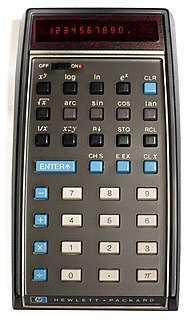
The HP-35 was Hewlett-Packard's first pocket calculator and the world's first scientific pocket calculator: a calculator with trigonometric and exponential functions. It was introduced in 1972.

The HP-65 is the first magnetic card-programmable handheld calculator. Introduced by Hewlett-Packard in 1974 at an MSRP of $795, it featured nine storage registers and room for 100 keystroke instructions. It also included a magnetic card reader/writer to save and load programs. Like all Hewlett-Packard calculators of the era and most since, the HP-65 used Reverse Polish Notation (RPN) and a four-level automatic operand stack.
RPL is a handheld calculator operating system and application programming language used on Hewlett-Packard's scientific graphing RPN calculators of the HP 28, 48, 49 and 50 series, but it is also usable on non-RPN calculators, such as the 38, 39 and 40 series.
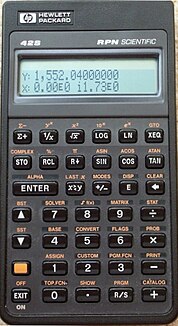
The HP-42S RPN Scientific is a programmable RPN Scientific hand held calculator introduced by Hewlett Packard in 1988. It has advanced functions suitable for applications in mathematics, linear algebra, statistical analysis, computer science and others.

The HP-22S is an electronic calculator from the Hewlett-Packard company which is algebraic and scientific. This calculator is comparable to the HP-32S. A solver was included instead of programming. It had the same constraints as the 32S, lacking enough RAM for serious use. Functions available include TVM and unit conversions. Only single letter variable names are allowed. Marketed as a student calculator, the 22S uses infix notation rather than the reverse polish notation used on some higher-end HP calculators of the same era.

The HP-32S was a programmable RPN Scientific Calculator introduced by Hewlett-Packard in 1988 and discontinued in 1991. It continued the tradition of the HP-15C programmable RPN Scientific Calculator. But some functions of the HP-15C were omitted and some were reduced in functionality, so to some extent it is more correct to say that the HP-32S expanded upon the HP-34C. It supported complex math, statistics, probability, and other functions.
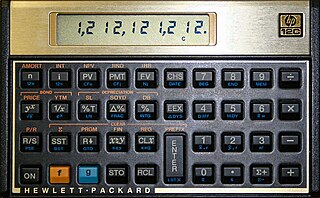
The HP-12C is a financial calculator made by Hewlett-Packard (HP) and its successor HP Inc. as part of the HP Voyager series.
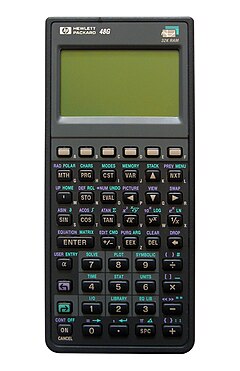
HP calculators are various calculators manufactured by the Hewlett-Packard company over the years.

The HP-25 was a hand-held programmable scientific/engineering calculator made by Hewlett-Packard between 1975 and 1978. The HP-25 was introduced as a cheaper alternative to the ground-breaking HP-65.
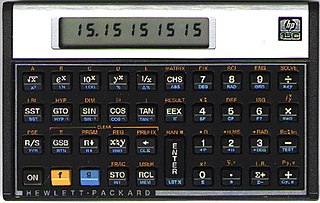
The HP-15C is a high-end scientific programmable calculator of Hewlett-Packard's Voyager series produced between 1982 and 1989.
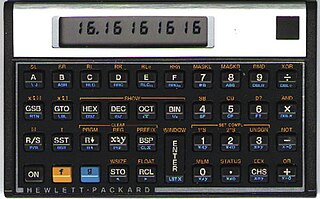
The HP-16C Computer Scientist is a programmable pocket calculator that was produced by Hewlett-Packard between 1982 and 1989. It was specifically designed for use by computer programmers, to assist in debugging. It is a member of the HP Voyager series of programmable calculators. It was the only programmer's calculator ever produced by HP, though many later HP calculators have incorporated most of the 16C's functions.

The HP-28C and HP-28S were two graphing calculators produced by Hewlett-Packard from 1986 to 1992. The HP-28C was the first handheld calculator capable of solving equations symbolically. They were replaced by the HP 48 series of calculators, which grew from the menu-driven RPL programming language interface first introduced in these HP-28 series.

The HP-27 was a hand-held scientific and financial, but not programmable, calculator made by Hewlett-Packard between 1976 and 1978.

The HP 35s (F2215A) is a Hewlett-Packard non-graphing programmable scientific calculator. Although it is a successor to the HP 33s, it was introduced to commemorate the 35th anniversary of the HP-35, Hewlett-Packard's first pocket calculator. HP also released a limited production anniversary edition with shiny black overlay and engraving "Celebrating 35 years".
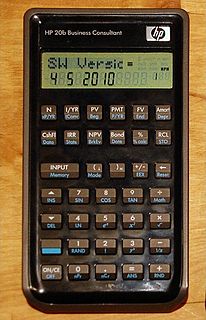
The HP 20b Business Consultant is a financial calculator published in 2008 by Hewlett-Packard. Its function is similar to HP 10bII and includes scientific and statistical functions.
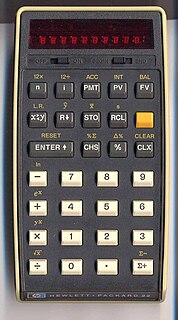
The HP-22 was a finance-oriented pocket calculator produced by Hewlett-Packard between 1975 and 1978. It was designed as a replacement for the short-lived HP-70, and was one of a set of three calculators, the others being the HP-21 and HP-25, which were similarly built but aimed at different markets.

The HP Prime is a graphing calculator introduced by Hewlett-Packard in 2013 and is currently not manufactured by HP Inc. It was designed with features resembling those of smartphones, such as a full-color touchscreen display and the ability to expand functionality by means of downloadable applications. It claims to be the world's smallest and thinnest CAS-enabled calculator currently available.
In computing FOCAL character set refers to a group of 8-bit single byte character sets introduced by Hewlett-Packard since 1979. It was used in several RPN calculators supporting the FOCAL programming language, like the HP-41C/CV/CX as well as the later HP-42S, which was introduced in 1988 and produced up to 1995. As such, it is also used by SwissMicros' DM41/L, both introduced in 2015, and is implicitly supported by the DM42, introduced in 2017.

















